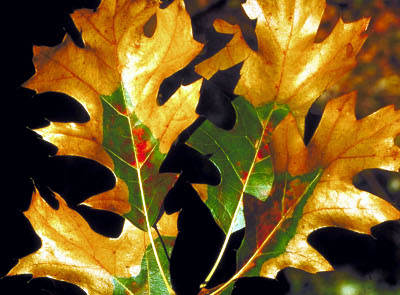Oak wilt: Diagnosing and preventing
Proper diagnosis of a wilt disease in oaks may prevent loss of surrounding trees.

When I think of oaks, I think of a tall stand of trees, possibly over a hundred years old, with a high canopy of deep green leaves that provide a sense of permanence. Last week I received calls from an arborist and a homeowner, both with the same problem: oak wilt. When apparently healthy oaks begin to die and surrounding oaks are dropping large amounts of leaves, it is devastating to watch.
Oak wilt, Ceratocystis fagacearum, is a fungal disease that moves through the vascular system (water conducting tissue) of the tree. The fungus spores are carried to the tree by small beetles that feed on sap from fresh wounds. These sap beetles that carry the disease from infected trees are attracted to fresh wounds from storm damage, pruning cuts or other injuries to previously uninfected trees. Once the beetles feed and the fungus moves into the vascular tissue, the tree reacts and tries to wall off the spread of the disease by plugging cells which causes branches to wilt. The disease can also spread from already infected oaks by moving through root grafts between trees of the same species. This is why oak wilt spreads so effectively between nearby trees.
Oaks are divided into two groups, the red oaks and the white oaks. Red oaks (pin, black and northern red) are more susceptible than the white oaks (white, bur, swamp white). Infected red oak trees can wilt and die within several weeks, while white oaks may survive for one or more years. The first symptom is browning leaves at the top of the tree. Leaves brown from their margins at the end of the leaf and continues to progress along the margins and down towards the mid-vein and stem of the leaf. Whole branches may be seen yellowing and then browning as the disease progresses down the branch. This is first seen in late spring to early summer. Leaves litter the ground around the tree as the tree wilts. Another symptom is a fungal mat that grows under the bark, creating pressure causing bark to crack. These fungal mats attract sap beetles where the insects pick up spores of the disease, carrying it to uninfected trees that are freshly wounded, releasing the spores as they feed.
A correct diagnosis is critical to reducing the spread of the disease. Since other disease and problems can be confused with oak wilt, Michigan State University Extension recommends having trees inspected by a certified arborist, and it would be beneficial to send samples to a diagnostic laboratory where the fungus can be identified. MSU Diagnostic Services advises to submit samples to their lab from partially wilted branches 1 inch in diameter. Cut branches into 6- to 8-inch lengths, place in bags to be delivered or overnight shipped to the lab. The MSU Diagnostic Services website provides directions on taking samples and how to submit samples. Fresh samples are necessary for testing for the oak wilt fungus.

Oak wilt disease symptoms on leaves. Photo credit: D.W. French, University of Minnesota, Bugwood.org
One simple measure that can help prevent the spread of oak wilt is to not prune any oaks during the growing season. This will prevent fresh wounds that draw in sap beetles that may be carrying the oak wilt fungus. Storm-damaged trees may need to be pruned during the summer to remove broken branches and when this is done, make sure all wounds are sealed with a tree wound dressing or latex paint. Sealing wounds must be done immediately since it is the fresh wounds that attract the beetles.
Once oak wilt is diagnosed it becomes important to limit the spread by cutting root grafts when other oaks are near the diseased trees. For more in-depth information on this process and other management options, read “Oak Wilt – Identification and Management” from Iowa State University Extension.



 Print
Print Email
Email